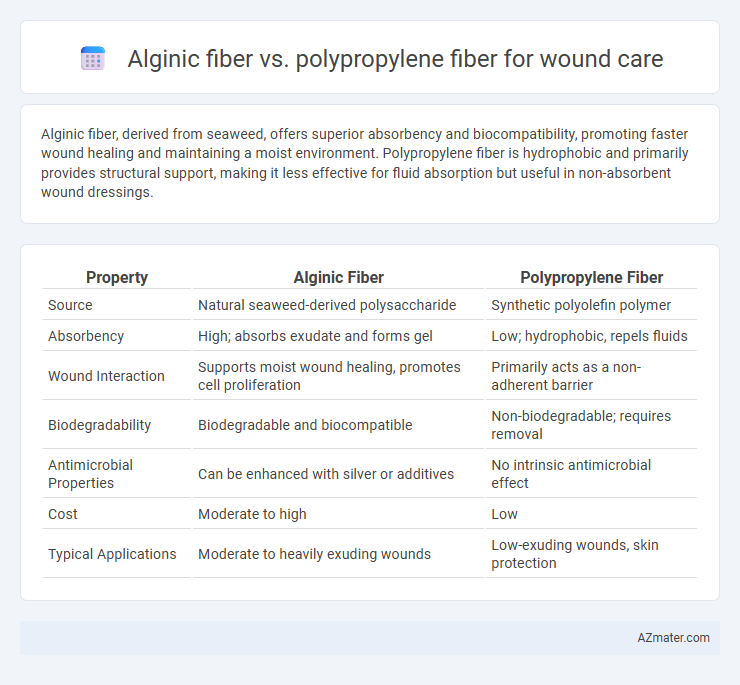Alginic fiber, derived from seaweed, offers superior absorbency and biocompatibility, promoting faster wound healing and maintaining a moist environment. Polypropylene fiber is hydrophobic and primarily provides structural support, making it less effective for fluid absorption but useful in non-absorbent wound dressings.
Table of Comparison
| Property | Alginic Fiber | Polypropylene Fiber |
|---|---|---|
| Source | Natural seaweed-derived polysaccharide | Synthetic polyolefin polymer |
| Absorbency | High; absorbs exudate and forms gel | Low; hydrophobic, repels fluids |
| Wound Interaction | Supports moist wound healing, promotes cell proliferation | Primarily acts as a non-adherent barrier |
| Biodegradability | Biodegradable and biocompatible | Non-biodegradable; requires removal |
| Antimicrobial Properties | Can be enhanced with silver or additives | No intrinsic antimicrobial effect |
| Cost | Moderate to high | Low |
| Typical Applications | Moderate to heavily exuding wounds | Low-exuding wounds, skin protection |
Overview of Alginic and Polypropylene Fibers
Alginic fiber, derived from brown seaweed, exhibits high absorbency and biocompatibility, making it ideal for managing moderate to heavily exuding wounds by forming a hydrophilic gel that promotes a moist healing environment. Polypropylene fiber, a synthetic polymer, offers superior tensile strength, chemical resistance, and minimal water absorption, commonly used as a reinforcing material in wound dressings to provide structural support without compromising breathability. Both fibers serve distinct roles in wound care: alginic fibers focus on exudate management and moisture retention, while polypropylene fibers enhance mechanical stability and durability in composite dressing applications.
Composition and Source of Alginic Fiber
Alginic fiber, derived primarily from brown seaweed species such as Laminaria and Macrocystis, is composed of alginate polysaccharides known for their high absorbency and gel-forming properties, making it ideal for managing moderate to heavily exuding wounds. Polypropylene fiber, a synthetic polymer made from propylene monomers, offers biocompatibility and structural support but lacks the natural bioactive components and moisture regulation capacity inherent in alginic fibers. The natural origin of alginic fiber provides enhanced moisture retention and promotes a moist wound healing environment, contrasting with the inert and hydrophobic nature of polypropylene fiber.
Key Properties of Polypropylene Fiber
Polypropylene fiber used in wound care offers excellent moisture resistance and high tensile strength, making it durable and less prone to bacterial growth. Its hydrophobic nature ensures minimal fluid absorption, reducing the risk of maceration and promoting a dry wound environment. Polypropylene fiber also provides flexibility and comfort, supporting patient mobility while maintaining wound protection.
Absorbency Comparison: Alginic vs Polypropylene
Alginic fiber exhibits superior absorbency compared to polypropylene fiber, absorbing up to 20 times its weight in fluid due to its hydrophilic properties and ability to form a gel upon contact with wound exudate. Polypropylene fiber is hydrophobic, providing minimal fluid absorption and primarily serving as a protective barrier rather than an absorbent layer. This makes alginic fiber more effective in managing moderate to heavily exuding wounds.
Biocompatibility and Patient Safety
Alginic fiber, derived from brown seaweed, offers superior biocompatibility by promoting a moist wound environment and supporting natural healing with minimal tissue irritation. Polypropylene fiber, a synthetic material, is less biocompatible due to its inert and non-absorbent properties, which may increase the risk of foreign body reactions or delayed healing. Patient safety is enhanced with alginic fibers as they reduce infection risks and are highly absorbent, whereas polypropylene fibers require careful management to prevent wound maceration and discomfort.
Antimicrobial Activity in Wound Healing
Alginic fiber exhibits superior antimicrobial activity in wound healing due to its natural ability to absorb exudate and create a moist environment that inhibits bacterial growth. Polypropylene fiber, while providing structural support and durability, lacks intrinsic antimicrobial properties and often requires additional treatment or coatings to prevent infection. Studies demonstrate that alginic fiber dressings enhance wound healing by reducing bacterial load and promoting faster tissue regeneration compared to polypropylene fiber-based dressings.
Moisture Management in Wound Care
Alginic fiber excels in moisture management by absorbing large amounts of exudate and forming a gel that maintains a moist wound environment, promoting optimal healing. Polypropylene fiber, while providing structural support, is hydrophobic and does not absorb exudate, making it less effective for moisture control in wound care. Effective moisture balance is critical in wound healing, and alginic fiber's superior absorption and gel-forming properties offer enhanced exudate management compared to polypropylene fiber.
Application Suitability for Different Wound Types
Alginic fibers excel in managing moderate to heavy exudate wounds such as diabetic ulcers and pressure sores due to their high absorbency and gel-forming properties, which promote a moist healing environment. Polypropylene fibers are best suited for dry wounds or as secondary dressings providing structural support and minimizing infection risks with their synthetic, non-absorbent nature. Selecting the appropriate fiber depends on wound exudate levels and healing stages, with alginates favored for heavily draining wounds and polypropylene for low-exudate or clean wounds.
Environmental Impact and Sustainability
Alginic fiber, derived from natural seaweed, is biodegradable and renewable, making it an environmentally sustainable choice for wound care dressings by minimizing landfill waste and reducing reliance on fossil fuels. Polypropylene fiber, a petroleum-based synthetic material, poses environmental challenges due to its non-biodegradable nature and persistence in ecosystems, contributing to microplastic pollution. The use of alginic fiber supports circular economy principles and lowers carbon footprint compared to polypropylene fiber, which requires energy-intensive production and complex recycling processes.
Summary: Choosing the Right Fiber for Wound Care
Alginic fiber, derived from seaweed, offers superior absorptive capacity and promotes a moist wound environment by forming a gel upon contact with exudate, making it ideal for moderate to heavily exuding wounds. Polypropylene fiber, a synthetic material, provides excellent tensile strength and durability but lacks the bioactivity and moisture retention properties essential for optimal wound healing. Selecting between alginic and polypropylene fibers depends on wound exudate levels and healing requirements, with alginic fibers preferred for managing high exudate and maintaining hydration, while polypropylene fibers are suited for structural reinforcement and non-absorbent wound dressings.

Infographic: Alginic fiber vs Polypropylene fiber for Wound care
 azmater.com
azmater.com